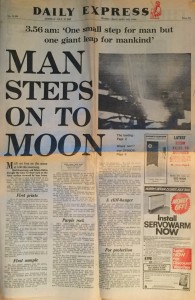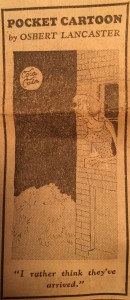![]() Its hard to believe that man first set foot on the Moon fifty years ago today. At the time the promise and adventure of space travel, especially for a generation brought up on the sci-fi of the fifties and sixties, seemed to be unfolding into a reality before our very eyes. TV , radio and newspapers all brimmed with enthusiasm for the project , carrying up to the minute reports of the mission’s progress. The Daily Express itself had the largest headline of all the broadsheets proclaiming in huge typeface “ Man steps onto moon”. The interior contained in-depth articles dealing with every aspect of the great undertaking, including speculation into the whereabouts of the un-manned Luna15 , which the Soviets had launched at the same time. Regular news stories were pushed to
Its hard to believe that man first set foot on the Moon fifty years ago today. At the time the promise and adventure of space travel, especially for a generation brought up on the sci-fi of the fifties and sixties, seemed to be unfolding into a reality before our very eyes. TV , radio and newspapers all brimmed with enthusiasm for the project , carrying up to the minute reports of the mission’s progress. The Daily Express itself had the largest headline of all the broadsheets proclaiming in huge typeface “ Man steps onto moon”. The interior contained in-depth articles dealing with every aspect of the great undertaking, including speculation into the whereabouts of the un-manned Luna15 , which the Soviets had launched at the same time. Regular news stories were pushed to  the farther pages where Hawke himself could be found in a story called “The daughter of Eros
the farther pages where Hawke himself could be found in a story called “The daughter of Eros
Members of the US administration were publicly and confidently predicting that Mars would be reached before the year 2000. Who would have guessed then, amid all the exhilaration of the moment that after 1972 no other human footprint would be made upon the Lunar surface for another half century?
For me the best piece in the Express that morning was the acerbic little pocket cartoon by Osbert Lancaster , which appeared next to the front page headline. Skipper Prossitt 
It’s interesting to see the Daily Express front page for Monday 21st July 1969. The front page of the Scottish Daily Express was quite different, with photos of Armstrong and Aldrin, and a Moon map to show where they were. Almost the only thing they have in common is the Osbert Lancaster cartoon, and that has a precursor of which neither the cartoonist nor the paper may have been aware.
In 1956 the London Evening Standard commissioned Arthur C. Clarke to write a series of short stories about an international mission to the Moon, collected afterwards in his anthology “The Other Side of the Sky” and reprinted in “Arthur C. Clarke, The Collected Stories” (Gollancz, 2000). The participants were the British, the Americans and the Russians. In a story called ‘Watch This Space’, towards the end of their stay the Americans are to recapitulate an experiment conducted by sounding rocket from White Sands in 1955, releasing a cloud of sodium vapour to fluoresce in sunlight at high altitude. It’s to be done from the Moon on a scale to be visible from Earth…
“… a sudden yellow glow began to spread across the sky, like a vast and unwavering aurora that became brighter even as we watched. It was as if an artist was sprawling strokes across the stars with a flame-filled brush. And as I stared at those strokes, I suddenly realised that someone had brought off the greatest advertising coup in history. For the strokes formed letters, and the letters formed two words – the name of a certain soft drink too well-known to need any further publicity from me.
“How had it been done? The answer was obvious. Someone had placed a suitably cut stencil in the nozzle of the sodium bomb, so that the stream of expanding vapour had shaped itself to the words. Since there was nothing to distort it, the pattern had kept its shape during its invisible ascent to the stars. I had seen skywriting on Earth, but this was something on a far larger scale. Whatever I thought of them, I couldn’t help admiring the ingenuity of the men who had perpetrated the scheme. The O’s and A’s had given them some trouble, but the C’s and L’s were perfect.”
Actually there’s only one L, but there’s no need to be pernickety. Like Sydney with his prediction of the Moon landing date, once again as so often, Arthur was ahead of the game.